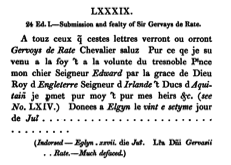Rait Castle owners and occupants
It is rather difficult to sort out the truth behind Rait castle and its ownership over the centuries since the stories of treachery, capture and recapture seem similar and are probably blurred with time, as are the dates. And it all depends which clan is recounting the tale! Below are extracts from several accounts of the history and occupants of Rait castle.
----------
The earliest lords of Rait of whom contemporary record exists took their designation from the manor of Rait, and although nothing certain is known of their origins they are reputed to have been Comyns [see W. D. Simpson (1937), "Rait Castle and Baraven Church", PSAS LXXI (1936-37), pp98-115, p109]. The manor is first on record in an estate list of 1238 [see Registrum Episcopatus Moraviensis, ed. Cosmo Innes, Edinburgh 1837, p34]. References to Sir Gervaise de Rait and his younger brother Sir Andrew are frequent in the last decade of the thirteenth century. Both were well connected in the king's business, and in 1304 Sir Andrew was employed in a survey of the royal lands in Scotland. Unless the manor were a timber building, of which no evidence is visible in the neighbourhood (not even by a motte hill upon which it would presumably have been raised), this defensible hall-house must be the eponymous manor of the Raits, and of the late thirteenth or early fourteenth century, a likely enough conclusion, architectural evidence concurring with historical probability.
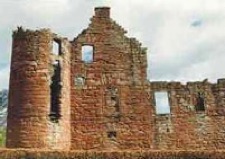
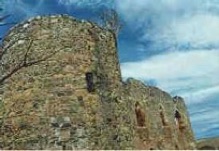
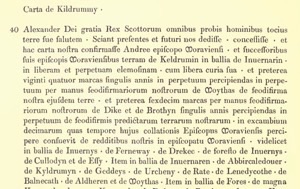
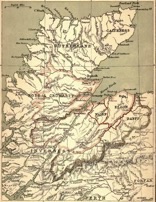

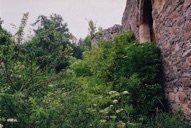
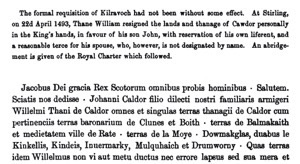
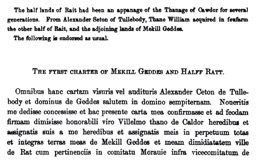
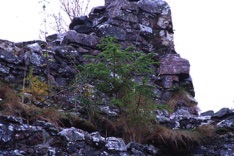
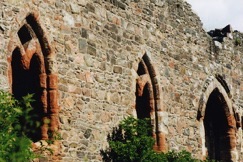
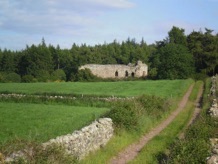
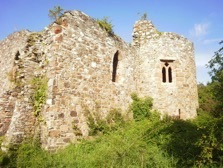
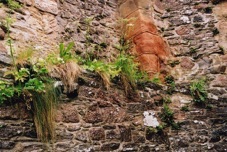
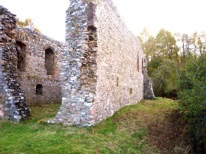
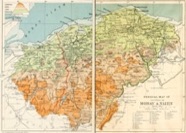
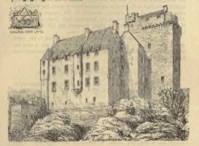
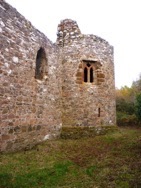
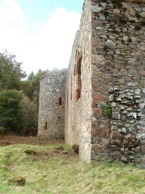
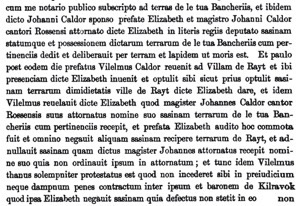
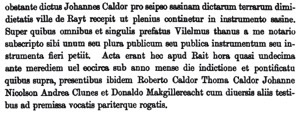
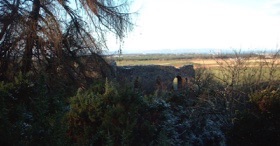
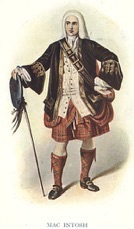
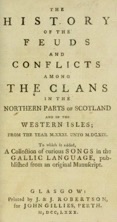
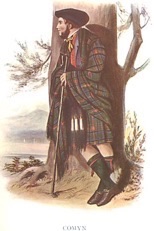
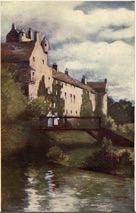
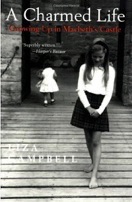
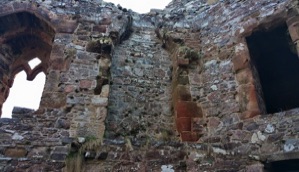
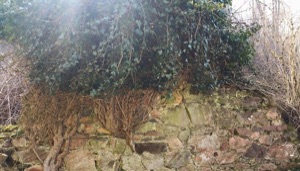
© both photos Sunshine Howells, 2015
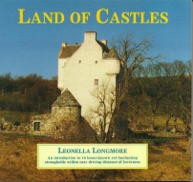
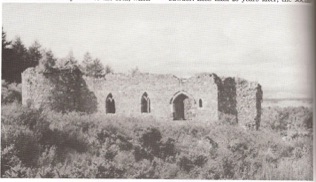
William Chalmers Raitt (1917-2011) provides additional details on Rait Castle in his personal account of the History of the Raitts in which he covers their origins, the earliest Raitt, the Cummings, and the Raits of Rait Castle. Another short account, giving details of the background, purpose, layout, features and condition of Rait Castle can be found written by Eleanor Buchanon.
----------
The page on Rait lands provides additional details on who owned the Rait estates at various times and in a blog entry on the Castles of Rait I have attempted to shed some light on whether or not Gervase de Rathe actually resided at Rait Castle. Additional photos of Rait Castle can be found on a separate page.
In volume 5 of the Ordnance Gazetteer of Scotland: a survey of Scottish topography, edited by Francis H. Groome and published in 1884, part of the text under the entry for Nairn reads:
“Threequarters of a mile E of Geddes House are the ruins of Rait Castle, anciently the seat of the Mackintoshes of Rait, and prior to that of a branch of the Cumyns, and also, it is said, of the family of Rait of Rait, which disappeared from the county in the end of the 14th century, and became, according to Shaw in his History of the Province of Moray. the founders of the family of Rait of Halgreen in Kincardineshire. The last of the Nairn family was, according to the same authority, Sir Alexander Rait, who, between 1395 and 1400, murdered the then thane of Cawdor. There seems also to have been at an early date a chapel here dedicated to the Virgin Mary; for incidental mention is made in 1343 of 'the hermit of the chapel of St Mary of Rait.' Close to the castle are the remains of an old British fort, called Castle-Findlay.”
----------
There are not many recent books or documents on Scottish castles that describe Rait Castle in other than a few lines. One of the few that does is Land of Castles by Leonella Longmore and published by The Inverness Courier in 1993. In the six pages, not only are the surroundings and architecture of the castle described, but also its turbulent history. According to the author’s text, Rait castle, dating from the 13th century, was the work of Sir Gervaise de Rait and his younger brother Sir Andrew, both of whom were prominent supporters of Edward I. But who were the de Raites, possessors of one of the oldest Thanedoms in Nairnshire? The earliest recorded owner was Shaw, the fourth chief of the Mackintosh clan, who before 1265, had obtained a grant of Meikle Geddes, the Castle of Rait [but if the Castle already existed at this time, then perhaps Gervaise rebuilt it in the stone we see today rather than original wood?] and, in marriage, had acquired the daughter of the Thane of Cawdor. Less than 20 years later, the Comyns put an end to the Mackintosh possession of the Thanedom. As it was the custom for Norman knights of the period to drop their surnames, the records of the period refer to them simply with the territorial title “De Rathe”. These were the Raites who supported Edward I. Their loyalty did not go unsupported - Sir Gervaise was appointed Constable of the Castle of Nairn, while Sir Andrew was made the trusted bearer of dispatches to Edward during the War of Independence. The author goes on to say that the de Raites propensity to side with the English may explain the unique features of the dignified ruin - which is unlike any other castle in the area. The pointed, ornamental Gothic windows of the first floor give an immediate impression of the ecclesiastical, contradicting the defensive quality of the small square apertures and narrow loopholes on the ground floor.
It is evident that this is a building of a class superior to the ordinary keeps that abound in the North of Scotland. Radically different from the towerhouses of neighbouring Cawdor and Kilravock castles and vastly superior to Inshoch, Rait seems to have been built by a master mason par excellence, one seemingly familiar with the fine, ecclesiastical, Gothic building that was going on in Moray during the 13th century - such as in the Abbeys of Elgin, Pluscarden and Kinloss. Notwithstanding its ecclesiastical nature and its Hermit’s Chapel, Rait was never a church for there are frequent references to “Rait with its fortalice” and to the “Castletown of Rait”.
Having decided to oppose Robert the Bruce in the War of Independence, the Raites chose as badly as did their powerful relations, the Comyns, whose subsequent downfall must have affected the fortunes of all the family. The Mackintoshes, who supported Bruce, were quick to remember that Rait had belonged to them and their subsequent massacres of the Comyns is said to have led to the abandonment of Rait Castle. It was Comyn of Raite who, realizing that it was his own daughter who had betrayed them, cut off her hands as she hung from the window through which she tried to escape. Rait Castle continued to be a bone of contention among the local aristocracy. The Raites and the Cawdors were constantly at each other’s throats since Cawdor had supplanted Raite as Constable of Nairn Castle. Then around 1404/1405 Sir Alexander Raite of Raite killed Andrew, Thane of Cawdor, and was forced to flee to The Mearns.
What puzzles historians, the author goes on to say, is what happened in the 40 year gap before the “half-lands of Rait” appear in a title in favour of Cawdor dated at Inverness in 1442. The other half, including the castle now associated with the lands of Meikle Geddes, were granted in a charter to the Mackintoshes. So the Raites lost their lands to the Cawdors and Mackintoshes - and it is not inconceivable that Castle of Rait remained empty for no powerful chief would have wanted a rival on his doorstep. A century later Cawdor purchased the castle and all the lands.
Leonella Longmore's little chapter talks of other legends regarding Rait Castle and describes how one, Nathan S. Raitt, spent much of his life researching his ancestry and how the locals remember him asking endless questions and scrabbling round the ruins in search of answers!
Despite all this feuding between the Comyns and the Mackintoshes, it may have just been very minor and localized. In the book The history of the feuds and conflicts among the clans in the northern parts of Scotland and in the Western Isles; from the year M.XXXI unto M.DC.XIX, published in 1780, there is no mention at all of any feud or conflict between these two clans - although Clan Chattan makes frequent appearances.
----------
A first hand account of Rait Castle is given by Liza Campbell - the last child to be born at nearby Cawdor Castle in which grounds Rait lies.
“…..on a damp autumn day when we had driven over to Rait Castle to look for puffballs.
Rait was a tiny wreck. No floors or roof remained, but there was an elegant stone fireplace halfway up the interior wall - evidence that the main living area was on the first storey with livestock stabled beneath to provide a natural form of underfloor heating. It was more pied-a-terre than castle, arid it was ours, as much as it was anyone's. It came as part of a medieval compensation package for the 1405 murder of Andrew Cawdor, heir to the 4th Thane, by Sir Gervaise de Rait. Although his name was better suited to a choreographer than an assassin, he had not only put the Cawdor bloodline at risk, but his audaciousness had threatened the family's local reputation. As deaths go, it was infra dig. If it were a farmyard bust-up it would have been like a stud rooster getting savaged to death by a blue tit, in front of all the hens.
The Raits already had a reputation for punching above their weight. Some time before, the Rait Castle thane felt he had a bone to pick with another of his neighbours and invited the family over to dine with him, with the express intention of murdering them all between courses. Unbeknown to him, one of his daughters was having an illicit affair with the son of one of his intended victims. The prevailing culture of endless hostilities made enemies so thick on the ground that it was frankly hard for a girl not to get romantically involved with one of the enemy's sons every now and again. When she overheard her father detailing the plot with his stewards, she rushed off to their trysting spot and warned her lover. The boy alerted his family, but instead of cancelling the dinner date, they kept it. At a prearranged signal, the Raits drew their skean-dhus. Instead of being taken unawares, their guests followed suit. In the midst of the snickersnee, it dawned on the girl's father exactly who had betrayed his plans. He raced to his daughter's room and burst in upon her just as she was escaping. She was hanging from the windowsill, about to drop down onto her lover’s horse tethered below. Rait ran straight over and hacked off both her hands.
Sir Gervaise fled into exile after killing Andrew Cawdor. The confiscation of the castle was intended to discourage any further challenges to the Cawdor authority. Raitt Castle was too small and too close to Cawdor to be of any use so it was left to fall into disrepair.”
From: A charmed life: growing up in Macbeth’s Castle. Liza Campbell. Thomas Dunn Books, 2006. Pp 183-185.
Addtiional details are to be found in the Macpherson’s Invereshie Book. Here it notes that “the
McIntosh’s motto is the same as Clunie’s. He quarters for arms, a lyon for Macduff, supported by two wild cats. He bears also a dagger, pointing downwards alluding to the McIntoshes cutting off the Cummings in their own Castle of Raites, an account of which follows:-
Cumming, the Earl of Badenoch and Athole, was denominated the Wolf of Badenoch. The great and powerful Clan of the Cummings were almost cut off by private quarrels, and their opposition to King Robert Bruce. Their war with the Macintoshes was long, and of the most inveterate kind. A desperate battle was fought betwixt the two Clans at Leac na Maigh, near Moy, not far from Inverness, where the Cummings were defeated with great slaughter. This did not however, end the quarrel. As McIntosh on his way home, passed through a wood, his servants (who had gone a considerable way before their master) were found hung up upon the trees at the wayside, when their Chief came up. At last Cuming of Rait pretended to make peace; and with all intention to destroy the whole Clan, he invited McIntosh with his followers to a feast. McIntoshe was to be placed at the head of the table, and Cumming himself was to be at his right hand; the rest of the two Clans were to be seated in the same manner i.e. a Cumming on a McIntosh’s right, from the Chief down to the lowest man, as a particular mark of their friendship now commenced between them; a bull’s head was to be brought in as a signal to the Cummings, for every man to stab his left hand neighbour, being a McIntosh. But unluckily for Cumming, he revealed this design to a gentleman who was a well-wisher to McIntosh, and for the better security took his oath to keep it secret; the gentleman, however, contrived a method to reveal it to McIntosh without breaking his oath. As they were walking the fields he desired McIntosh to stand on one side of a large stone that lay in their way, while he went to the other, and in McIntosh’s hearing told Cummings plot to the stone; upon which McIntosh convened his Clan in all haste, who were no sooner got together, then an invitation was sent for them to feast, and, according to the custom of the times, it was cowardly not to accept it. Accordingly they went well prepared. Cumming met them on the way, and told them his method of entertainment, and hoped they would be so kind to comply with it. Macintosh answered that he would not, but, on the contrary, he would give Cumming the preference, otherwise he would not enter; Cumming with some reluctance at last agreed to it; both clans seated themselves according to the last proposal; the Macintoshes had their eye constantly on the door; at last the bull’s head appeared, and the Macintoshes drew their daggers, and treated the Cummings in the same means in which they were intended to be treated themselves.
The Castle Scotland website provides yet another perspective and additional details about Rait Castle and its owners, as well as a description which will be found on the Rait Castle architecture page..
“Rait is an oblong hall tower over an unvaulted undercroft. It is found between Auldern and Cawdor, 3 miles South-East of Nairn. The road to the castle is named “Rait Castle Farm”.
Rait castle was once the Barony and ancient Thanedom of the Northern sept of the Raits, before being won by the Comyns (Cummings). The castle was of some importance, being situated on route between Inverness and Forres. It has many unusual features dating from the 14th century. The Raits, who held the Thanedom in 1238 appear to have been a very strong clan, their Chief's holding the Lordship of Meikle Geddes, Rait and Petty, the rich agricultural plain near Inverness. At this time the lands in the area were held by both the Clan Chattan ( led by Clan Mackintosh) and the de Raits who were pro-Edward in the Wars of Independence. Two of the Raits of that Ilk, Sir Gervaise and Sir Andrew de Rait both took active part in battles in support of the English. The Raits were removed from the castle after King Robert I was installed and Angus Chattan, a supporter of the Bruce was installed.
The Comyns were descended from a brother of the Black Comyn. They became established in Altyre in Moray but made no change to their quarrelsome Comyn ways. Robert the Bruce murdered The Red Comyn in a church in Dumfries in 1306. After this time and even now, the Chief of the clan was Comyn of Altyre. In 1424, Robert Comyn, 13th Chief of Altyre seized control of the Cattan/MacKintosh lands of Meikle Geddes and Rait. (It was Robert, the who married a Gordon heiress, thus bringing the Gordonstoun land into the family. All generations since have been named Gordon-Cumming, the name of the present chief of Altyre).
The rivalry came to a head with a massacre of the Comyns at Rait. After the loss of their lands, the united clans of Chattan and Mackintosh of Moy became a thorn in the sides of Comyn of Rait. He invited the Mackintosh and Chattan to a grand banquet at the castle, apparently to heal the rifts between the families. The invitation was accepted but the Mackintosh were warned in time that the Comyns planned to slay their guests. Laird Comyn had put the household under oath not to reveal the plot to any person but his young daughter, anxious for the safety of a Mackintosh, who was her lover, disclosed the plot. She spoke the story to a large boulder near the castle, knowing that her lover was behind it, it being their meeting place. The stone can still be seen and is called 'The Stone of the Maiden'.
The Mackintoshes attended the feast but with each man hiding a dirk in his plaid. At length, a bull’s head was brought in and toasted in "Memory of the Dead". This was the signal agreed upon for the slaughter of the guests. The Comyns rose and were about to draw their swords but the Mackintoshes, being forewarned drew their daggers and thrust them into the Comyns. The Chief escaped and rushed to an upper chamber where his daughter was who he believed had given the information. The young lady sought to escape by leaping out of the window. She held onto the window sill but he cut off both of her hands with a broadsword and she fell her death.
The local tale is that a girl with no hands still haunts the ruins.
The local sept of the Comyns was very much diminished after this time. The seat of Comyn returned to Altyre and the remaining Comyns were slowly ousted by their Mackintosh and Macpherson neighbours. The Comyns were driven to wild and lawless deeds, and on one occasion, in reprisal, Alexander Macpherson, known as ‘The Revengeful’, slew nine of their chief men in a cave in which they had resorted to hiding in. The last of the clan fled the area after the slaying of the Thane of Calder (Cawdor) in whose hands the lands are still held today.
From the History of the Province of Moray (Vol 2) by Lachlan Shaw, published in 1882, we learn that close by Geddes is Raite Castle - an old Fort, built in the form of a square, which was anciently the seat of Raite of that Ilk, who, having killed Andrew Thane of Calder about the year 1404, was banished that county, and founded the family of Raite of Halgreen in the Mearns. Donald, Andrew’s son, was served heir to his father in 1405, and was confirmed in the offices of Sheriff and Constable of Nairn in 1406. A part of Raite was Calder's property in 1442; another part of it with Meikle Geddes, was the property of Ogilvie of Carnoustie, from whom Sir John Campbell of Calder made the purchase in 1432. (Elsewhere in the same work, he notes that Sir John Campbell of Calder, in 1533, purchased from John Ogilvie of Carnousie, Meikle Geddes, Raite, and the Fort of it). Sold again, in 1678 Sir Hugh Calder purchased Raite Castle and Raite Lone from John Hay of Lochloy.
The later Editor of Shaw’s work adds a note to the effect that “Two miles east of Cawdor, and near the House of Geddes are the ruins of Raits Castle, anciently the seat of the Macintoshes of Raits. The castellated part is gone, but a religious edifice, apparently of a more modern date than it could have been, remains. At the south corner it is terminated by a round Tower (lately formed into a dovecot) resembling those attached to the bishop's palace at Kirkwall and Spynie.”
Mackintosh of Mackintosh had in feu from Huntly in the sixteenth century the lands of Rait amongst others.
© both photos Alastair Cunningham - Save Rait Castle, 2010
The Mackintoshes, who greatly assisted Bruce at Bannockburn, revived the claim to Raite, but Angus, the Chief, for some reason, was not restored to his paternal estates, but was recompensed by other lands. The Mackintoshes, however, still remembered that Raite rightfully belonged to them they also pretended some claim to Kilravock - and Alexander Lord Gordon, on 5th October 1442, granted a charter to Mackintosh of the lands of Raite and Meikle Geddes, which charter (says Mr Fraser Mackintosh) is still extant. A tradition exists that the name of Knocknagillean (now Skenepark) was given to it in consequence of the Cumings having hanged five young men of the Mackintosh clan on the trees on a little heioght—Knock-na-gillean meaning the "Hill of the Lads."
In the Statistical Account of Scotland for the parish of Croy and Dalcross, the tragic incident which led to the abandonment of the Castle was first related, and the traditionary account in the locality differs from it only in fuller details The story is to the effect that Cuming of Raite, under the guise of a desire to bury former animosities and establish friendly relations, invited the Mackintosh and his followers to a grand banquet at Raite. The invitation was accepted; the Mackintoshes, never doubting, prepared to attend. They were, however, timely warned that the Cumings in this had planned a foul plot, and that at a given signal each Cuming would rise and slay his defenceless guest. Old Cuming had put all his household under a solemn oath that they would not reveal the plot to any person, but his daughter, anxious for the safety of young Mackintosh, who was her lover, found a way to disclose the plot. She went to a large boulder some distance from the Castle, and told the whole story to the stone, but she knew her lover was behind it, as it was their usual trysting place, and he would hear every word. The stone to this day is called "The Stone of the Maiden." The Mackintoshes, notwithstanding the warning, resolved to attend the feast. When the night of the banquet came, each Mackintosh hid his dirk in his plaid, but gaily took his seat around the festive board of Cuming of Raite. The revelry ran high, and the walls of the old Castle resounded with the mirthful shouts of the carousers. At length the toast is given " The Memory of the Dead." This was the signal agreed upon for the slaughter of the guests. The Cumings rose and were about to draw their swords, but the Mackintoshes, being forewarned were forearmed, and with a yell of derision sprang to their feet, drew their daggers and thrust them into the hearts of the Cumings. Among the few who escaped death, it is said, was the Chief of the Cumings, who flew to an upper chamber where his daughter was, whom he believed to have given the information, as he knew the girl and the young Mackintosh were lovers. Seeing the maddened state of her father, the young lady sought to escape from him by leaping out of the window, but before she could do so, he cut off both her hands with a broadsword. From the night in which the tragedy was enacted, the bloodstained walls of Raite have been tenantless. So runs the tradition.
Historically there is no improbability in the story, and the only difficulty is in reconciling it with the statement of Shaw that "about the year 1404," in consequence of Raite having killed Andrew, Thane of Cawdor, he was banished the County of Nairn, and settled in the Mearns where he founded the family of Raite of Halgreen. There is a difference of forty years between the date given by Shaw and that of the charter to Mackintosh. The explanation may probably be that while the father was banished, a son may have remained who became the actor in the tragedy. The "half-lands of Rait" appear in the Cawdor titles for the first time in 1442, the very year of the tragic occurrence. The Mackintoshes never took possession of the lands. While Cawdor obtained the one half with the mill, the Setons retained the other half with the Castle and the lands of Meikle Geddes - these latter properties some time after passing into the hands of the Ogilvies of Durn and Carnoussie, and ultimately to the Cawdor family, in whose possession they now are.
In view of the importance of Rait Castle and the central role it appears to play in the history and origin of the name Raitt, then I believe it is worth quoting as many texts as I come across in an effort to understand more. One old book by George Bain entitled the History of Nairnshire and published by the Telegraph Office in 1893 has a substantial amount on Rait and its occupants including Gervaise in several places. Early is his History, Bain writes,
“[The Norman family de Ros] Rose first appears at Geddes in 1230. Hugh Rose obtained a charter for Kilravock from the King in 1293. Rose of Geddes had for his neighbour Sir Gervaise de Raite. Gervaise was a Cuming—a family also of Norman origin and Northumbrian connection, which rose to great power in Scotland, The fortunes of the Cumings were made when William Cuming married Marjory, the daughter of the old Celtic Maormer of Buchan, and succeeded him in that position as Earl of Buchan. His son Walter obtained the Lordship of Badenoch, and when at the height of their power they could boast of four Earls, the Lord of Badenoch (a mighty potentate,) and thirty belted knights in the family, with lands far and near. Some doubt has been cast on the connection of Gervaise de Raite's family with the Castle of Raite at Geddes, it being thought more probable that Raite Castle in Badenoch was their seat, but a receipt which appears in the State Papers puts an end to all question on the point. It bears that Thomas de Braytoft, governor of the Castles of Nairn and Cromarty, receives his salary by the hands of Gervaise de Raite, constable of Invernairne. It is dated at Raite, March 6, 1292, and cannot refer to any Raite but that of Nairn.
The Castle of Nairn, along with the others, was handed over to King Edward I's officers and garrisoned by English troops. Thomas Braytoft, who had been at Nairn the year before as an envoy to bring the Maid of Norway home, was appointed governor of the Castles of Nairn and Cromarty. Thomas Braytoft continues in command of the garrisons at Nairn and Cromarty, and draws his pay from time to time. His receipt, already mentioned as being granted to Sir Gervaise de Raite, runs thus—" To all .who may see or hear of these presents, I, Thomas de Braytoft, Keeper of the Castles of Nairn and Cromarty, on behalf of the illustrious King, Lord Edward, by the grace of God, King of England, constituted Overlord of the Realm of Scotland, greeting Know all men that I, on Thursday preceding the Feast of Pope St. Gregory, in the year of our Lord 1292, received by the hands of Sir Gervaise de Raite, Knight, constable of Nairn, as the dues and arrears of the bailieship of Invernairn, for my service and custody of the Castles of Nairn and Cromarty, £11 sterling. In witness whereof I have granted these presents to Sir G.—Given at Raite, day and year foresaid."
Following the ascension to the throne of John Baliol, Edward’s choice, Thomas de Braytoft, governor of the Castles of Nairn and Cromarty, received a copy of this letter dated at Berwick, 18th November, 1292, and immediately caused the colours of John Baliol to be hoisted upon the two fortresses under his charge.
Edward's progress North was practically unopposed, and the chief men of the districts through which he passed hastened to make submission to him…... The news of Edward's triumphant progress had reached the north, and knights and barons deemed it expedient to do him homage. Accordingly we find Stirling of Moravia leaving his house at Cantray and proceeding to Aberdeen to meet the King. The Ogilvies, great lords of Strathnairn, are there too. Reginald Chien, the Hays of Lochloy, Robert le Falconer, William de Moravia, and others, all hasten to Aberdeen and make their submission. Gervaise de Raite is not with them, but he appears and swears fealty when the King has come into Moray, and doubtless surrenders to him the royal Castle of Nairn.
In the autumn he [Edward] summons a Scottish Parliament at Berwick, and amongst those who attend are Sir Reginald Chien, Sir Gervaise de Raite and Sir Andrew de Raite, from the County of Nairn.
Moray is once more in insurrection. The Royal Castles are attacked and besieged, and many of the English soldiers slain. Henry Chien, Bishop of Aberdeen, the Earl of Mar, and the Countess of Ross, attempt to put down the insurrection, but without avail. Sir Andrew of Raite appears to have taken an active part along with them, and he was sent south as the bearer of despatches to Edward, to give an account of the services rendered by these friends.
Further on in his book, Bain has more to say on the Raites of Raite and their Castle.
“The Douglas Rebellion [in 1452] produced considerable changes in Nairnshire. It brought an accession of wealth to the houses of Cawdor and Kilravock, and while it occasioned the downfall of the Earl of Ross and the Douglases, it led to the rise to great power and influence of the family of Gordon in the North. Alexander Seton married the heiress of Gordon, and assumed the name of his wife. His son, Alexander, who was styled Lord Gordon, was rewarded with large estates and important offices for the part he took in overthrowing the tiger Earl of Crawford, or as the King said, " for haudin' the Croon on our head." He was created Earl of Huntly, and his second son George, who succeeded him, virtually ruled the North.
A transaction of Alexander, Lord Gordon, a few years before the Douglas Rebellion led indirectly to the extinction of the family of Raite of Raite. The history of Raite, though involved in some obscurity, can be pretty accurately traced from existing writs. The earliest possessors of Raite were the Mackintoshes. Shaw Mackintosh, the fourth chief of the Clan, before 1265 obtained a grant of Rothiemurcus and the lands of Meikle Geddes and Raite. He is said to have married Helen, daughter of the second recorded Thane of Cawdor. Ferquhard his son succeeded him, and dying in 1274, left an only child Angus. During the minority of Angus, the Cumings took possession of Raite and Meikle Geddes and other lands which belonged to Mackintosh. As Norman knights, they dropped their surname and appear in the records of the period simply with the territorial title "De Rathe." In the deed executed in the latter part of the reign of Alexander III. by Elizabeth Bisset, conveying the lands of Kilravock to Mary her daughter and Hugh Rose of Geddes her son-in-law, "Gervaise de Rate" is one of the witnesses. When Edward I. of England came North in the year 1296, one of the knights who made submission during the King's stay at Elgin was Sir Gervaise de Raite. His letter tendering his loyalty and obedience on the occasion is published in Palgrave's Documents and Records Illustrating the History of Scotland. It is written in Norman-French. In the roll of the Parliament held at Berwick by Edward on his return South, the names of Sir Gervaise de Raite and Sir Andrew de Raite, father and son, appear. "When the War of Independence broke out. Sir Andrew de Raite took the side of Edward against Bruce, and his mission to London in connection with Sir Andrew Moray's doings in the Province of Moray has been already narrated (see Letters referring to Andrew de Rait). The downfall of the powerful family of Cuming of which they were a branch, and the overthrow of the political party to which they had attached themselves, could not have left the Knights of Raite unaffected. Sir Andrew, as has been shown, filled the office of Constable of the Castle of Nairn, when Thomas Braytoft held it for Edward. Soon after the close of the War of Independence the Thane of Cawdor holds that office.
© both photos Alastair Cunningham - Save Rait Castle, 2010
In the 19th edition of Burke’s Landed Gentry (though not in much earlier editions) under the lineage of John Lachlan Mackintosh of Mackintosh, it is recorded that Ferquhard Mackintosh, 3rd of Mackintosh who was brought up by Earl of Moray and quoted as Seneschal of Badenoch, died 1240 and was succeeded by his nephew Shaw Mackintosh, 4th of Mackintosh who (after 1236) acquired Meikle Geddes and the castle of Rait. Shaw died in 1265 and was survived by son Ferquhard, 5th of Mackintosh, who was chosen to lead the Badenoch people against the Norwegians for Alexander III. After his death also in 1265 and in the minority of his only son Angus, the Comyns seized Meikle Geddes and Rait castle amongst others and these were not recovered by the Mackintoshes for another 100 years. Angus Mackintosh, 6th of that Ilk, was supported by Robert the Bruce in the fight against the Comyns - in 1319 he received a grant of lands in Badenoch, from which the Comyns had been expelled by Bruce.
A century later, Malcolm, 10th of Mackintosh and his clansmen were invited in 1442 to a feast at Castle Rait by the Comyns who, though they had offered reconciliation with the Mackintoshes, secretly sought revenge for having been defeated by them some years previously. However, a Comyn lad warned a lass of the Mackintosh clan with whom he was in love and told her that when a boar’s head was born into the feast this would be a signal for the attack of the Comyns. Therefore, when the head appeared, the Macintoshes fell on the Comyns, slaughtered them and regained the castle of Rait, which together with Meikle Geddes, also regained in 1442 had been held by the Comyns for one hundred years. (Another version from the Comyn’s history side relates that it was Comyn’s daughter who revealed the plot to her Mackintosh lover).
If Gervaise and Andrew de Rait were in occupation of the Rait lands (and presumably the castle) at least in the 1290s, then if the above scenario is correct they must have been resident there during the times of the Cumyns occupation (after 1265), especially if a descendant (Alexander) fled to the Mearns in 1405, their lands were forfeited and the castle itself was not recovered by the Mackintoshes from the Cumyns until 1442! However, if the present ruined Rait Castle was not constructed until the early 14th century at the earliest, then Gervaise and Andrew were unlikely to have lived in it.
© both photos Alastair Cunningham - Save Rait Castle, 2010
There was a query in The Scottish Historical Review, vol 2, 1905, p104-105 by A.M.M (A.M. Mackintosh?) regarding Rait Castle, near Nairn. The question has some preamble as is reproduced.
“The description of this ruin given by Lachlan Shaw (Hist. Moray , edit 1775, p.111 - see below) is “an old fort, built in the form of a square, which was anciently the seat of Raite of that Ilk, who, having killed Andrew, Thane of Calder, about the year 1404, was banished that country and founded the family of Raite of Halgreen in the Mearns.” In the edition of 1882 of the same work a note by the editor (vol. ii. p. 265) speaks of the castle as “anciently the seat of the Mackintoshes of Raits' (sic) and continues: “the castellated part is gone, but a religious edifice, apparently of a more modern date than it would have been, remains.” The existing ruins do not give the impression of such age as Shaw's description would imply, and they seem to me to have more of an ecclesiastical than of a baronial character. What is the probable age of the buildings, and how far is it a religious edifice?
As to the history of the building and its occupiers Shaw gives no authority for his statement concerning the family of Rait. Tradition, as reported in the Statistical Account, associates the buildings with the Cummings, and local legend makes it the scene of a slaughter of Cummings by Mackintoshes. Some people say that the Raits were a branch of the Cummings. The Mackintosh connection with the castle is beyond dispute, as appears from writs still extant at Moy Hall, the earliest of which is a precept, dated 5th Oct. 1442, by Alexander de Seton, knight, lord of Gordon, to William, Thane of Calder, as his bailie, directing him to give sasine to Malcolm M'Kyntosch in the lands of Meikle Geddes and the half of the lands of Rait with the castle thereof. The charter on which this precept proceeds was dated at Inverness on the preceding day. Towards the end of the century a charter of the land and castle was granted by Alex. Seton of Tullibody, eldest son of the foresaid Alex. Seton (1st Earl of Huntly), to the Thane of Calder, to whose family the other half of Rait already belonged, but the Mackintoshes still asserted rights, and a dispute arose between them and the Campbells of Calder, successors of the old thanes, which was not settled until 1521. The Ogilvies of Boyne also had claims in respect of Rait.
Is anything known of the history of Rait Castle prior to 1442, or when it ceased to be used as a residence? It is sometimes confounded with Raitts in Badenoch, held by the Mackintoshes of Borlum for nearly two hundred years down to 1788.”
© both photos Alastair Cunningham - Save Rait Castle, 2010
The well-known legend of the massacre of the Comyns by the Mackintoshes at Rait Castle is told in the New Statistical Account of Scotland under the united parishes of Croy and Dalcross, Invernessshire, and more fully by Bain (see below); but the difficulty is to dovetail the incident into the authenticated history of the ownership. The Rev. Alexander Campbell, Minster of the United Parishes of Croy and Dalcross, wrote in his account of the parishes in September 1841, “To the west of the church, there is a large grey stone, called clach na scanaish, that is, "the listening stone," commemorative of those barbarous deeds which too frequently disgrace the memory of our ancestors. The Cummings, conceiving they had received some offence from the Mackintoshes, were determined to be revenged, and, concealing their bloody purpose, invited the Mackintoshes to the Castle of Rait, where all animosities should be buried in oblivion at the festive board. One of the Cummings, from compunction of conscience, or regard for one of the intended victims, sent private notice to one of the Mackintoshes to meet him at the grey stone, to which, addressing himself in the audience of his friend, he disclosed the bloody and treacherous intentions of his clan. The Mackintoshes being thus made aware of the design of the rendezvous, nothing daunted, repaired to the castle at the appointed hour, and, before the Cummings could give the signal for attack, each Mackintosh plunged a dagger in the bosom of a Cumming, and only saved the life of the man who communicated the treachery to the grey stone.”
A briefer version appears in the Statistical Account of Scotland for the parish of Nairn. Writing in 1794, the Rev. John Morrison commented: “On the N. side of the hill of Geddes are to be seen the vestiges of an old edifice, about 26 yards long, and nearly half as broad. It is called Caisteil Fionlah, i. e. Finlay's Castle. It has been built with run, or burnt lime, and surrounded at some yards distance with a ditch. The ditch is drawn round the middle of the detached hill, or rising ground on which the house was built, and is still very visible. At the bottom of this little hill, on the S. E. there appears to have been a sunk, or draw-well for the use of the castle. Even tradition does not say by whom, or for what purpose this edifice was erected. A little to the E. on the side of the same hill of Geddes, are the remains of the Castle of Rait, built probably by Rait of that ilk, but at what period is uncertain. It was, for some time, the residence of one of the Cummines; and considering the time at which it seems to have been built, it appears to have been a house of great strength. A little below this castle, is a place called Knock-na-gillan, i. e. the bill where the young men or lads were killed. Here, it is said that 18 of the Mackintoshes were destroyed by the Cummines, who then lived at Rait, on account of some grudge that subsisted between the families.”
The Rev. James Grant repeated the same text in his description of the parish of Nairn in the New Statistical Account of Scotland dated 1845.
What became of the family of de Rait is not certainly known, but it is said that the last of them, Sir Alexander, had to flee the neighbourhood in 1404 for slaying Andrew, Thane of Cawdor, and that thereafter he founded the family of Rait of Hallgreen in the Mearns. At all events there was a Thane Andrew who was newly dead before 11th July 1405, on which day his son obtained a precept of sasine as Sheriff of Nairn and Constable of its castle. The devolution of the manor of Rait remains obscure until 1442, when it was granted to the Mackintoshes. At Moy Hall there still exists "a precept, dated 5th October 1442, by Alexander de Seton, Knight, Lord of Gordon, to William, Thane of Cawdor, as his bailie, directing him to give sasine to Malcolm Mackintosh in the lands of Meikle Geddes and half of the lands of Rait "with the Castle thereof. The charter on "which this precept founds was dated at Inverness on the preceding day. Towards the end of the century a charter of the lands and castle was granted by Alexander de Seton of Tullibody, eldest son of the foresaid Alexander Seton (first Earl of Huntly) to the Thane of Cawdor, to whose family the other half of Rait already belonged, but the Mackintoshes still asserted rights, and a dispute arose between them and the Camphells of Cawdor, successors of the old Thanes, which was not settled till 1521." (In the Cawdor charter chest is a grant of feu-farm by Alexander Seton of Tullibody to the Thane of Cawdor, conveying to him "my lands of Meikle Geddes and my half of the ville of Rait," but not mentioning the Castle. It is dated at Elgin 26th October 1493).
The half of the lands of Rait that belonged to the Thanes of Cawdor included the mill, as appears from a writ in the Cawdor charter chest, dated 17th August 1442. In 1501, owing to the non-entry of Alexander Seton of Tullibody, the other half of the lands were bought from the Crown by Walter Ogilvie of Boyne. This action was resisted by the Thane of Cawdor, who "in the hall or house of Geddes," on 29th May 1501, solemnly annulled the sasine by the ceremony of breaking a dish and casting it into the fire. Notwithstanding this, the Ogilvies succeeded in retaining possession until finally the lands were bought from them by Sir John Campbell of Cawdor, by a contract dated at Elgin 16th July 1532. Even then the Ogilvies reserved the superiority, and so, when John Campbell of Cawdor succeeded his father as a minor in 1551, his uncle, the Prior of Ardchattan, in his capacity as tutor-in-law to the young laird, obtained a gift of non-entry of these lands from Alexander Ogilvie of Carnousie and Burn, " superior of the landis of Geddes and Rait, with the fortalice liand in the samyn." The "fortalice of Rait” recurs in a service of John Campbell of Cawdor as heir of his father, given at Nairn on 16th November 1596.5 The Hiltown and Castletown of Rait are on record in 1622. At what date the castle ceased to be occupied does not seem to be known, but it is perhaps significant that in Gordon of Straloch's map, circa 1650, Raitloan is shown but not Rait Castle.
Somewhere near the castle was the chapel of St Mary of Rait, with a hermitage of which Nicholas the Hermit was the occupant in 1343.”
© both photos Alastair Cunningham - Save Rait Castle, 2010
The great revolt against English domination had now broken out in Morayland, and the lords of Rait remained true to Edward. At the end of July Sir Andrew de Rait was sent back by the Bishop of Aberdeen with a letter to the King detailing the efforts that had been made to stamp out the rising. "He can tell you these affairs in all points," wrote the Bishop, "for he was in person at all these doings." Sir Andrew travelled south along with a cleric, Bernard de Mouat, and carried with him letters to the English King from the Countess of Ross and the Earls of Mar and Strathearn. Before leaving Scotland they had an audience of the notorious Hugh de Cressingham, Edward's rapacious Treasurer of Scotland, who was afterwards slain at Stirling Bridge, and is said to have had his skin flayed from his corpse and made into saddle girths by the infuriated Scots. Cressingham evidently had his reasons for distrusting Sir Andrew, for on 5th August 1297 he writes from Berwick to his royal master warning him that "Sir Andrew Rait is going to you with a credence which he has shown me, and which is false in many points and obscure, as will be shown hereafter, as I fear; and therefore, Sire, if it be your pleasure, you will give little weight to it."
In 1304 Sir Andrew de Rait was employed in making a survey of the King's lands in Scotland. At this period the residence of the de Raits, like most contemporary Scottish castles, will have been a construction of timbered earthwork. Whether or not it was on the site of the later stone building we cannot say.
Besides extensively describing the architecture of Rait Castle, in his 1937 article Simpson also provides details on the history of Rait. He notes that “the Thanedom of Rait was one of the oldest manors in Nairnshire. It is first on record among a list of estates in the bailiewick of Nairn in the year 1238. The statement has been made that its original owners were Mackintoshes, and that Shaw, fourth chief of that clan, married Helen, a daughter of the Thane of Cawdor, and before 1265 obtained a grant of Meikle Geddes and Rait. Be this as it may, its earliest lords of whom we have contemporary record took their territorial designation from the manor, and nothing certain is known as to their origin, though they are said to have been Comyns. Sir Gervaise de Rait appears as witness to the charter granted by Elizabeth Bisset, conveying the lands of Kilravock to her son-in-law, Hugh Rose of Geddes: this charter is undated, but seems to belong to the closing years of Alexander III's reign. The form of the name therein is [Gervasio de] Rath, which means simply "fortress." Under the provisional government established by Edward I during the contested succession, Sir Gervaise was constable of the castle of Nairn, and takes from its keeper, Thomas de Braytoft, a receipt for the latter's salary, dated at Rait, Thursday, 8th March 1292. His name is found in the Ragman Rolls among a list of Scottish magnates who at Elgin, on Friday, 27th July 1296, gave in their allegiance to the all-conquering Plantagenet; and his letter of submission is still extant. Sir Gervaise de Rait, with his younger brother Sir Andrew, attended as vassals of the English King at the parliament summoned by him at Berwick on 28th August following. Early in June of next year Sir Andrew de Rait was in England, and on the 11th of that month King Edward at Ospringe issued two documents affecting him. The first was a letter patent signifying that the King had committed to his liege Andrew Rait all the lands of Gervaise Rait, his brother in Scotland, presently in the King's land. The second was a safe conduct for him "going on the King's particular business to Scotland," and authorising him to use the public horses.
© both images of Rait Castle by Eleanor and Clyde Moore, 2010
